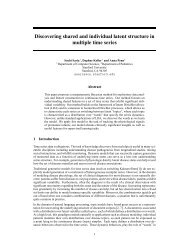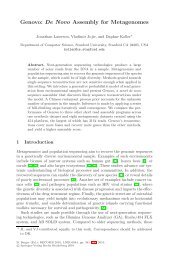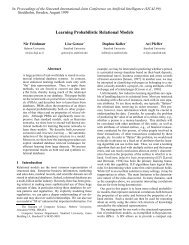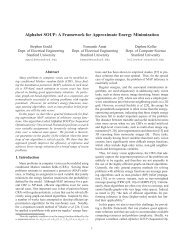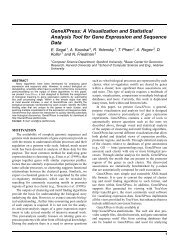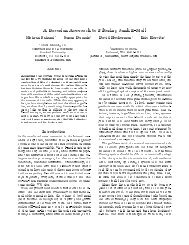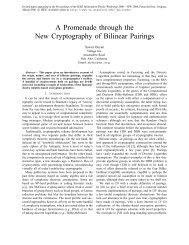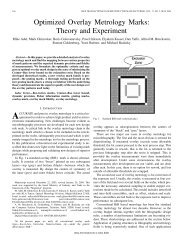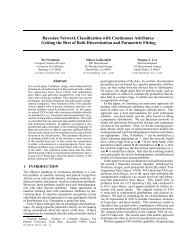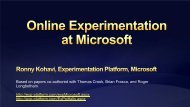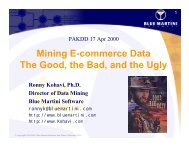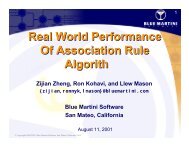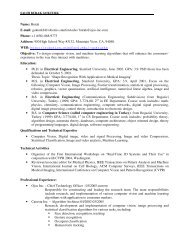Region-based Segmentation and Object Detection - Stanford ...
Region-based Segmentation and Object Detection - Stanford ...
Region-based Segmentation and Object Detection - Stanford ...
Create successful ePaper yourself
Turn your PDF publications into a flip-book with our unique Google optimized e-Paper software.
EXPERIMENT CARS PED.<br />
Patch baseline 0.40 0.15<br />
HOG baseline 0.35 0.37<br />
Patch RB (w/o cntxt) 0.55 0.22<br />
Patch RB (full model) 0.56 0.21<br />
HOG RB (w/o cntxt) 0.58 0.35<br />
HOG RB (full model) 0.57 0.35<br />
Figure 3: PR curves for car (left) <strong>and</strong> pedestrian (right) detection on the Street Scene dataset [2]. The table<br />
shows 11-pt average precision for variants of the baseline sliding-window <strong>and</strong> our region-<strong>based</strong> (RB) approach.<br />
4.3 Learning<br />
We learn the parameters of our model from labeled training data in a piecewise fashion. First, the<br />
individual terms are learned using the maximum-likelihood objective for the subset of variables<br />
within each term. The relative weights (η reg , η obj , etc.) between the terms are learned through crossvalidation<br />
on a subset of the training data. Boosted pixel appearance features (see [7]) <strong>and</strong> object<br />
detectors are learned separately <strong>and</strong> their output provided as input features to the combined model.<br />
For both the base object detectors <strong>and</strong> the parameters of the region <strong>and</strong> object terms, we use a<br />
closed-loop learning technique where we first learn an initial set of parameters from training data.<br />
We then run inference on our training set <strong>and</strong> record mistakes made by the algorithm (false-positives<br />
for object detection <strong>and</strong> incorrect moves for the full algorithm). We augment the training data with<br />
these mistakes <strong>and</strong> re-train. This process gives a significant improvement to the final results.<br />
5 Experiments<br />
We conduct experiments on the challenging Street Scene dataset [2]. This is a dataset consisting of<br />
3547 high-resolution images of urban environments. We rescaled the images to 320 × 240 before<br />
running our algorithm. The dataset comes with h<strong>and</strong>-annotated region labels <strong>and</strong> object boundaries.<br />
However, the annotations use rough overlapping polygons, so we used Amazon’s Mechanical Turk<br />
to improve the labeling of the background classes only. We kept the original object polygons to be<br />
consistent with other results on this dataset.<br />
We divided the dataset into five folds—the first fold (710 images) was used for testing <strong>and</strong> the<br />
remaining four used for training. The multi-class image segmentation component of our model<br />
achieves an overall pixel-level accuracy of 84.2% across the eight semantic classes compared to<br />
83.0% for the pixel-<strong>based</strong> baseline method described in [7]. More interesting was our object detection<br />
performance. The test set contained 1183 cars <strong>and</strong> 293 pedestrians with average size of 86 ×48<br />
<strong>and</strong> 22 × 49 pixels, respectively. Many objects are occluded making this a very difficult dataset.<br />
Since our algorithm produces MAP estimation for the scene we cannot simply generate a<br />
precision-recall curve by varying the object classifier threshold as is usual for reporting object detection<br />
results. Instead we take the max-marginals for each Cn variable at convergence of our algorithm<br />
<strong>and</strong> sweep over thresholds for each object separately to generate a curve. An attractive aspect of this<br />
approach is that our method does not have overlapping c<strong>and</strong>idates <strong>and</strong> hence does not require arbitrary<br />
post-processing such as non-maximal suppression of sliding-window detections.<br />
Our results are shown in Figure 3. We also include a comparison to two baseline sliding-window<br />
approaches. Our method significantly improves over the baselines for car detection. For pedestrian<br />
detection, our method shows comparable performance to the HOG baseline which has been specifically<br />
engineered for this task. Notice that our method does not achieve 100% recall (even at low<br />
precision) due to the curves being generated from the MAP assignment in which pixels have already<br />
been grouped into regions. Unlike the baselines, this forces only one c<strong>and</strong>idate object per region.<br />
However, by trading-off the strength (<strong>and</strong> hence operating point) of the energy terms in our model<br />
we can increase the maximum recall for a given object class (e.g., by increasing the weight of the<br />
object term by a factor of 30 we were able to increase pedestrian recall from 0.556 to 0.673).<br />
Removing the pairwise context term does not have a significant affect on our results. This is<br />
due to the encoding of semantic context through the region term <strong>and</strong> the fact that all images were<br />
of urban scenes. However, we believe that on a dataset with more varied backgrounds (e.g., rural<br />
scenes) context would play a more important role.<br />
We show some example output from our algorithm in Figure 4. The first row shows the original<br />
image (left) together with annotated regions <strong>and</strong> objects (middle-left), regions (middle-right) <strong>and</strong><br />
predicted horizon (right). Notice how multiple regions get grouped together into a single object.<br />
The remaining rows show a selection of results (image <strong>and</strong> annotated output) from our method.<br />
7




